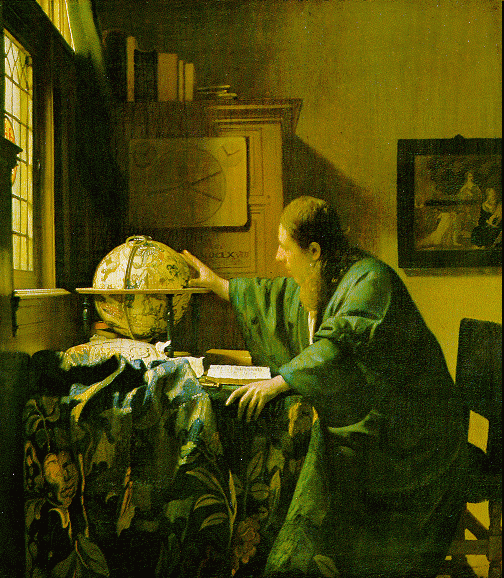
The Astronomer, Johannes Vermeer (1632-1675)

The Astronomer, Johannes Vermeer (1632-1675)
Astronomy:
The science that deals with the origin, evolution, composition, distance, and motion of all bodies and scattered matter in the universe. It includes astrophysics, which discusses the physical properties and structure of all cosmic matter. Astronomy comprises the study of all extraterrestrial objects. Until the invention of the telescope and the discovery of the laws of motion and gravity in the 17th century, astronomy was primarily concerned with noting and predicting the positions of the Sun, Moon, and planets, initially for calendrical and astrological purposes and later for navigational applications and scientific interest. The catalog of objects now studied is much broader and includes, in order of increasing distances, the solar system, the stars that make up the Milky Way Galaxy, and other more distant stellar objects and galaxies. With the advent of scientific space probes, the Earth also has come to be studied as one of the planets, though its more detailed investigation remains the domain of the geologic sciences.
Astronomy is the most ancient of the sciences, having existed since the dawn of recorded civilization. Much of the earliest knowledge of the celestial bodies is often credited to the Babylonians. They are thought to have recognized a number of prominent constellations as early as 3000 BC and to have developed a calendar based on the regularity of certain astronomical events some centuries thereafter. The ancient Greeks introduced various influential cosmological ideas. During the 6th century BC Pythagoras proposed the notion of a spherical Earth and a universe populated by objects whose motions were governed by the harmonious relations of natural laws. Later Greek philosophers taught that the sky was a hollow globe surrounding the Earth and having the stars inlaid like jewels on its inner surface. The sky was supported on an axis thrust through the Earth; on this axis the sky rotated westward daily, causing the celestial bodies to rise and set. During the 2nd century AD Ptolemy (Claudius Ptolemaus), one of the most celebrated of the ancient Greek astronomers, put forth a conception of an Earth-centred (geocentric) universe that influenced astronomical thought for more than 1,300 years. In the Ptolemaic system, each planet moved in a small circle, the epicycle, in the period of its actual revolution around the heavens relative to the Sun's position. Meanwhile, the centre of this circle moved eastward around the Earth on a larger circle in the observed period of the planet's revolution relative to the stars.
During the 16th century the Polish astronomer Nicolaus Copernicus disposed of much of the complexity of the Ptolemaic system by assigning the central position to the Sun. In this revolutionary system the Earth, attended by the Moon, became one of the planets revolving around the Sun. Copernicus also proposed the daily axial rotation of the Earth from west to east, so that the daily circling of the heavenly bodies around the Earth results simply from its apparent motion. Published in De revolutionibus orbium coelestium (1543), the Copernican heliocentric theory ushered in the age of modern astronomy.
The 17th century witnessed several momentous developments that led to major advances in astronomy. These were the discovery of the principles of planetary motion by Johannes Kepler, the application of the telescope to astronomical observation by Galileo Galilei, and the formulation of the laws of motion and gravitation by Isaac Newton. Other significant contributions followed in rapid succession. In 1750 Thomas Wright, for example, postulated that the universe was made up of numerous galaxies. Later in the century another English astronomer, William Herschel, undertook the first thorough telescopic survey of the heavens and established the foundations of modern stellar astronomy.
Spectroscopy and photography were adopted for astronomical research in the 19th century. They enabled investigators to measure the quantity and quality of light emitted by stars and nebulae (clouds of interstellar gas and dust), making it possible for them to conduct studies of the brightness, temperature, and chemical composition of such cosmic objects. It was soon recognized that the properties of all celestial bodies, including the planets of the solar system, could only be understood in terms of the physics of their atmosphere and interior. The trend toward the application of physical laws to the interpretation of observational data gained impetus during the early 1920s, and many astronomers began referring to themselves as astrophysicists. This tendency continues to prevail.
The major areas of current interest--X-ray astronomy, gamma-ray astronomy, infrared astronomy, and radio astronomy--are all basically concerned with physics and engineering, the knowledge of the latter having utmost importance in the construction of observational instruments and auxiliary equipment. Technological advances such as electronic radar and radio units, high-speed computers, electronic radiation detectors, and Earth-orbiting observatories and long-range planetary probes have greatly broadened the scope of both theoretical and observational research on astronomical phenomena.
Excerpt from the Encyclopedia Britannica without permission.